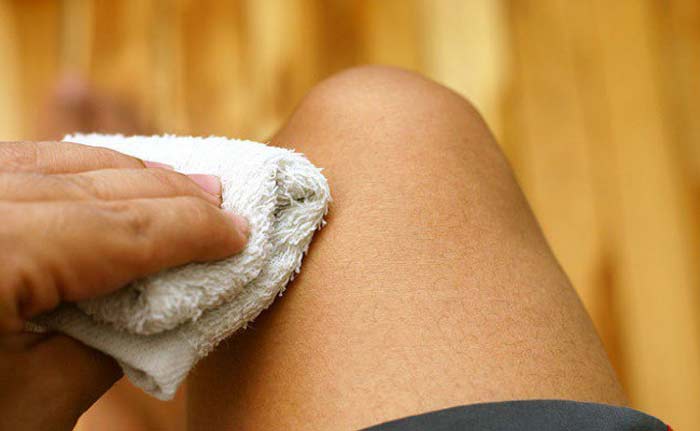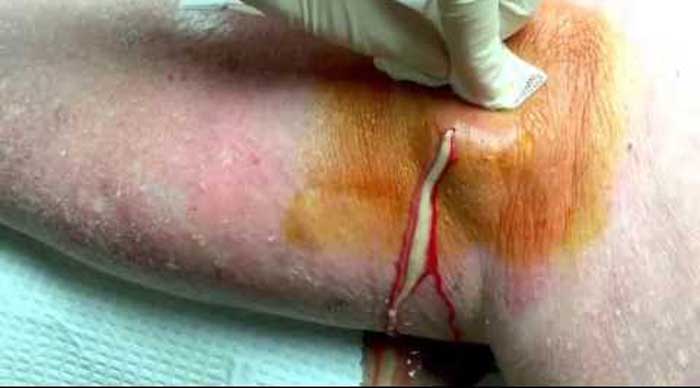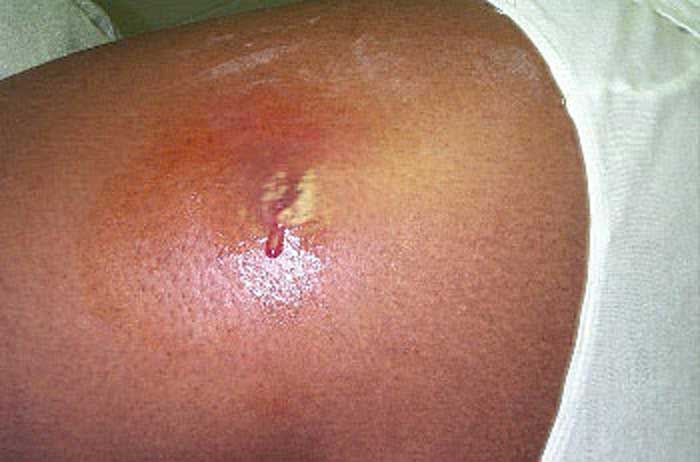Draining a boil can be a scary task when you imagine the pain you are likely to experience. It is not an easy task especially if you are on your own. Find out how to pop a boil or cyst, with no head, with a bottle at home in addition to pictures and videos
Boils & Causes
A boil is also known as a furuncle and is an infection of the skin that starts as a folliculitis. It is an abscess that is colonized by a bacterium known as Staphylococcus aureus.
There are various reasons that make you want to lance a boil or cyst among them the fact that they are associated with complications that involve spread into other surrounding tissues (cellulitis).
Boils or cysts are associated with some conditions including;
- Fever,
- Sepsis
- Internal abscesses
- Formation of a carbuncle
There are also rare strains of S. aureus that have cropped up among them methicillin resistant Staphylococcus aureus (MRSA) and Panto-Valentine Leukocidin (PVL) (British Association of Dermatologists and Cleveland Clinic).
Lancing a boil basically refers to the process by which a skin abscess is drained via a small operation. This may be carried under an anaesthetic normally a local anaesthetic. This local anaesthetic will not sedate you but will allow you to be conscious throughout the procedure.
At times referred to as popping a boil, lancing involves making an incision or cut to allow the pus to drain off the boil, collecting it and using a sample for a susceptibility test. This test allows a more rational choice of the antibiotic regiment to put you on for efficacy.
When the pus has been removed, the left-over ulcer is cleaned using a sterile normal saline solution (NHS)[1]. A dressing is made around the wound but allowing it to remain open so as to drain away any more pus easily.
A deep abscess is covered with an antiseptic dressing, a gauze wick. The procedure is medically known as incision and drainage but lancing is a more common term.
The procedure may leave a small scar.
Some skin abscesses are self-lancing meaning that they can drain naturally. They may even get better without need for treatment.
Why Drain a boil?
According to The Royal Gazette, many people lance boils due to the annoying nature of the boil. There are a variety of reasons that make people lance boils. These are enlisted below:
A boil could spread into a carbuncle:
The infection can spread and form other boils within the same area. This is known as a carbuncle. You can imagine having a cluster of boils under your armpit. How annoying! These require immediate medical attention, heal slower and usually leave multiple scars.
The skin is a grotesque red raised lump:
Aesthetics are an important consideration and this makes people get embarrassed with having a boil. Above all, the lump is pain and tender to touch.
A boil normally fills up with pus quickly and the longer they are left, they can easily rupture and drain themselves. But who has all this patience?
Boils occur in areas that interfere with comfort
Imagine a boil in the anal cleft, under the armpits or on the groin. These are areas that disallow your normal comfort and above all may create an embarrassing scene.
Boils may last longer than two weeks and may be accompanied by a fever
These two are really worrying and they should form the basis on which you should schedule a consultation with your doctor.
Need to select a specific drug for the pathogen:
Lancing and draining enables collection of specimen that can be used for determination of the best antibiotics to use instead of opting for empirical therapy or blind treatment.
The emergence of resistant strains of bacteria
Such as methicillin resistant Staphylococcus aureus (MRSA) and Panto-Valentine Leukocidin (PVL) these prolong the duration of the healing process (National Institute of Health).
Therefore, your doctor may want to collect a sample of the pus and perform a susceptibility test to determine the antibiotics the pathogen is resistant to.
Below are pictures of boil lancing in progress
How to Lance a boil at Home
Warm Compress Method
There are steps that you should follow below lancing a boil. First, you should have tried the compression method. The warm compress is preferred over the cold compress before lancing a boil. How do you apply a warm compress over a boil?
Warm compress normally helps the boil soften. The heat applied over the skin around the boil leads to increased circulation of blood through that area. This delivers more white blood cells to the area and makes healing faster.
You could use a warm flannel though you should remember to wash the flannel thoroughly afterwards. Do not use the flannel with other people to avoid spread.
Warm compress reduces the pain felt around the area in preparation for lancing, a more painful procedure. Lancing after this should be really easy just like on a ripened boil.
Remember that it is not recommended that you pop or squeeze a boil but rather let it drain on its own of lance it when ripe. Do not pierce or pinch the boil as it is prone to scar formation.
When it happens that the warm compress leads to a drain, then compress the skin around while pulling it outwards rather than squeezing it.
Disinfecting and numbing
Wash your hands: You should wash your hands with antiseptic soap before lancing. Wear some protective clothing such as latex gloves. Wash the area with some soap and clean water. You could also apply some Betadine or Avodine preparations with Povidone-iodine. If you do not have this, then you could opt for 75% ethanol or an Alcoswab.
Numb the area: You could use a local anaesthetic for this procedure. However, this should be used when you know how to.
Note that local anaesthetics such as Lidocaine need to be administered in measured recommended doses and co-administered with epinephrine to vasoconstrict the blood vessels in the area and prevent circulation of the Lidocaine.
This may lead to cardiovascular side effects and reduced duration of action. If you are doing this at home, use an ice pack to numb the area by placing it on the area for a few minutes.
Disinfect the equipment you will use: Use an unwrapped sterile scalpel if you are using one. If you are using a knife, then heat it until it turns red then let it cool. You could also use alcohol 75% to wipe the blade after this.
Prepare and ready your cotton wool or the gauze that you will dress the wound with when the boil drains.
How to Lance a Boil with no Head
This, if not treated with time leads to more complications. It is a more painful and larger boil than that which is common.
It is also deeply lodged into the skin and therefore close to the nerves. Seating on the nerves leads to more pain. It is a tougher version that require more expertise to deal with.
It is considered better to lance a boil during its early stage than in the later stage. In the early stage, the boil is red and sore while in the later stage, the boil is larger and not deeply lodged and may still have a head.
However, if it has not head, you can still find a way to lance it.
Do this;
- Visit a doctor as this require a professional to lance.
- The doctor will use a needle and syringe and surgically remove it. It takes much longer than dealing with a boil with a head.
- The needle may have to be inserted deeper into the skin.
How to Lance a Boil with a Bottle
This a grandma method that you could use. Here goes.
Step 1: use an empty glass bottle. Choose one with a fat body and small aperture to its mouth but with a long neck.
Step 2: heat it up by immersing it in hot water.
Step 3: now place the mouth of the bottle on top of the boil and use a wrapper in form of a cloth to cover it. A flannel soaked in cold water could be used instead of the cloth.
At this point, you will feel that the skin beneath the bottle is being sucked like happens in acupuncture. The vacuum effect makes the boil drain without necessarily incising or lancing it.
Step 4: Do this again to make sure that all the pus is drained. Cool use of Physics. You can make it hotter this time. The hotter it is, the better the suction and therefore the better the drainage. Make sure to collect the pus before it drains to other parts of the skin or dirties the sheets.
Other Ways to Pop a Boil or Cyst
Other ways are limited to surgical and popping it out. The surgical method is a last resort and is reserved for boils without a head and if does not respond to conventional treatment.
Once you have prepared yourself you are ready to lance. Do this at an angle but not at a right angle to the boil. Insert the needle or scalpel more than an inch and lift it up slightly to tear the boil from below.
- Clean your hands then rinse well.
- Prepare a ball of cotton wool and place them close to you
- Prick the boil using a sterilized pin or tweezers.
- Drain the pus.
- Use the cotton wool to collect the drain and dispose it well
Lancing Infected Boils
Want to see boil popping in action?



